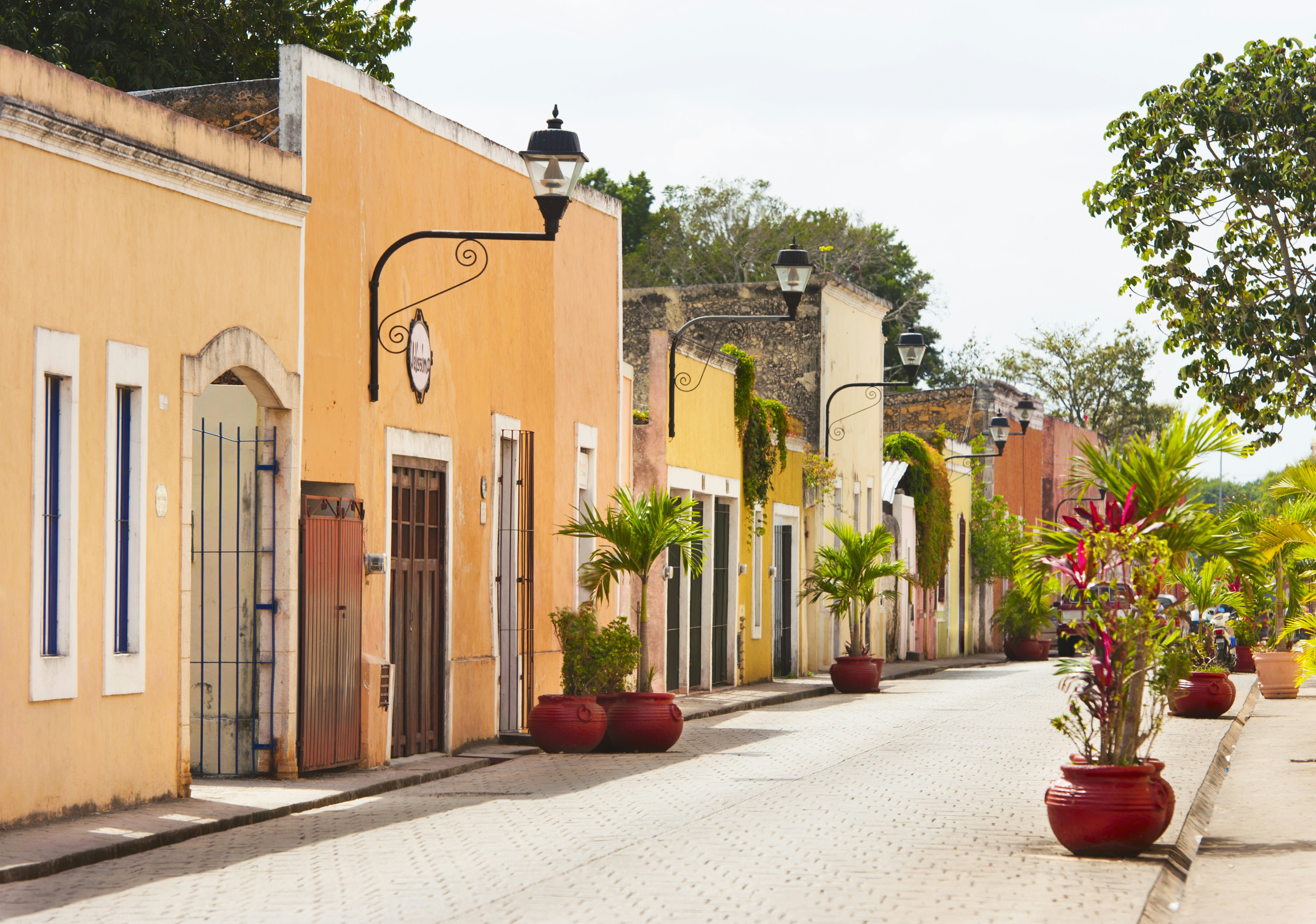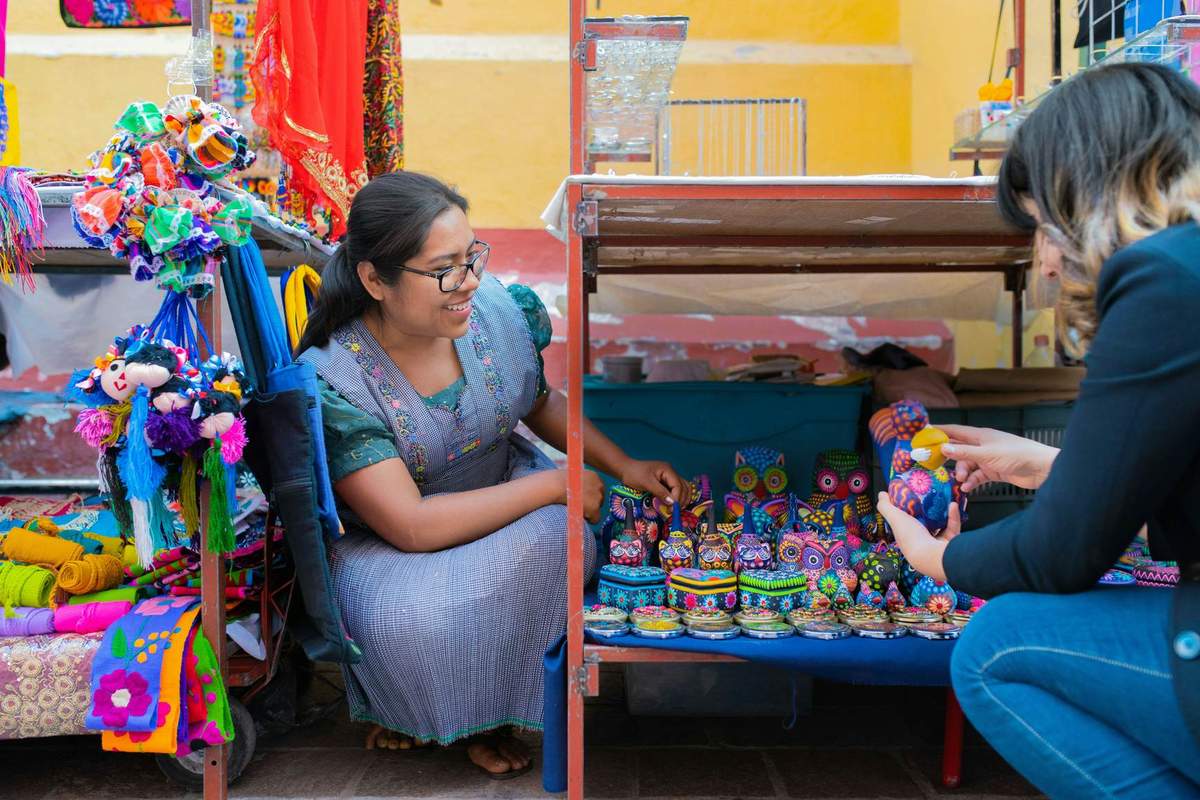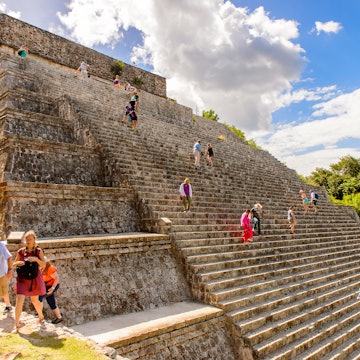

Go cenote hopping on the Yucatan Peninsula on a day trip from Playa del Carmen. Tiago Fialho/Shutterstock
Flanked on one side by the world's second-biggest reef and acres of untamed tropical forest on the other, Playa del Carmen is the perfect hub from which to explore the wild and wonderful Yucatán Peninsula.
As one of Quintana Roo's biggest cities, there is plenty of fun to be had in Playa del Carmen and the warm welcome you receive will make it difficult to tear yourself away. But everyone needs a break from the urban buzz and there's a wealth of fun adventures on your doorstep.
From laidback islands and outdoor adventures to stunning Maya ruins in the depths of the jungle, these are the best day trips you can take from Playa del Carmen.
1. Take a cenote tour on the Yucatan Peninsula
If there’s one thing worth dragging yourself away from the shores of Playa del Carmen, it’s the cenote (freshwater springs). Under the thick jungles of the Riviera Maya lies a dreamy underworld of natural turquoise pools and water-filled caverns. Swim amidst clear-as-glass waters, with stalactites overhead and ancient boulders beneath your feet, while spider monkeys and iguanas roam the lush tropical forest surrounding you.
The Maya civilization revered the cenotes and made sacrifices here as offerings to the gods. Today, they are equally venerated by outdoor adventurers drawn to this unique setting.
Over 6000 of these freshwater pools are peppered around the Yucatán Peninsula, and a few of the lesser-known ones are found near Playa del Carmen. A trio of cenotes – Azul, Cristalino, and Eden – are located side by side, making it easy to do a cenote-hopping tour of your own in just one day. All three are open-air pools with water deep enough for grownups to plunge into from the cliff’s edge and shallow pools for the little ones to wade in.
How to get to the cenotes from Playa del Carmen
The three cenotes are just a 25-minute drive south along 307 Highway. Each one has its own entrance gate, car park and changing facilities. To get there on public transport, head to the lineup of colectivos (shared vans) on Avenida Juarez, under the highway underpass, and catch one going in the direction of Tulum. Let the driver know where you’re going, and he’ll drop you off at the cenote’s entrance.

2. Snorkel in Akumal next to wild turtles
Don’t let the inviting panorama of swaying palm trees and sugary sand fool you – the real star of Akumal lies beneath the waves that lap its shores. Thanks to the seagrass meadows and the protective Mesoamerican Reef, Akumal is the best place to snorkel alongside turtles in the Riviera Maya. If you’re lucky, you might even spot manta rays and squid.
It’s mandatory to join a guided tour if you want to snorkel within the protected area. Standard prices of M$400 Mexican pesos (US$19.60) per person include snorkeling gear and life vests. Seafood restaurants and hotels line the beach, serving fresh but overpriced seafood, ceviche and tacos.
How to get to Akumal from Playa del Carmen
By private car, Akumal is just 40 minutes from Playa. Drive south along Highway 307, taking the exit to Playa Akumal. Continue to the beach, and there’s plenty of parking close to the entrance. If you don’t drive, take a colectivo from Juarez Avenue towards Tulum. Let the driver know you’re going to Akumal and he’ll drop you by the highway exit – from there, it's a 15-minute walk to the beach.
3. Explore laidback Isla Cozumel in a Jeep
As the ferry sails towards the dock in Isla Cozumel, the first thing you’ll notice are the schools of technicolored fish swimming in the shimmering spearmint water beneath the pier. The beach by the ferry terminal is clean yet gloriously empty, which begs the question: where are the tourists?
With its low-key flair and empty beaches, Cozumel is where Playa del Carmen's locals go to escape from the hubbub of the mainland. Time your visit when there are no cruises docked here, and you’ll have the island to yourself. To explore at your leisure, hire a Jeep for the day and drive the 30-mile (48km) loop around the island.
First, drop in at the San Gervasio Ruins, a pilgrimage center for the Maya. Head southeast and drive alongside the rugged windward coast until you reach Punta Sur Ecological Park. Spot crocodiles on a boat ride along its saltwater marsh and climb to the top of the Celarain Lighthouse – both of which are included in your entrance ticket. End your day trip on a high note with a snorkeling excursion to El Cielo, where you can swim off the Mesoamerican Reef.
How to get to Isla Cozumel from Playa del Carmen
Cozumel is an easy 45-minute ferry ride from Playa del Carmen. High-speed ferries depart regularly every day. Ultramar and Winjet run the route but on different schedules but both have comfortable, air-conditioned ferries that leave on time. Ticket prices start from M$290 (US$14.20) each way.

4. Marvel at the ancient ruins of Tulum
Reclining majestically on clifftops overlooking azure waves, the Tulum archaeological site sets itself apart from other ancient cities with an atypical coastal setting. These ruins may not have the immaculately restored pyramids of Chichén Itzá, but they capture your imagination with a clear grid layout and temple structures.
You can easily see the ruins in two hours – don’t forget your swimsuit so you can enjoy the beach beneath the site. A refreshing dip in the ocean is a wonderful way to cool down after exploring the site under the hot sun. This is a very popular attraction; arrive at 9am for the best chance to have the place to yourself.
How to get to Tulum ruins from Playa del Carmen
The Tulum archaeological zone is an easy one-hour drive south along the 307 Highway from Playa del Carmen. If you prefer public transport, take a colectivo from Avenida Juarez towards Tulum and let the driver know where you're going – he'll stop next to the entrance. The ADO bus also runs hourly services from Playa del Carmen to Tulum, with comfortable reclining seats and air conditioning.

5. Escape the crowds at the secret cenote at Laguna de Kaan Luum
When you tire of the crowds, take time out in the little-known Laguna de Kaan Luum, a perfectly circular lagoon that sparkles with different shades of blue in the sunlight. A cenote sits right in the middle of the lagoon, its dark indigo waters shimmering in contrast to the shallow aqua patches. Climb the viewing tower for a perfect view of the contrast.
Mainly popular with locals, Kaan Luum has miraculously escaped the major tourist radar despite being just a 15-minute drive from Tulum town. You’ll find a trickle of visitors if you get here before 11am or after 3pm, but it’s busy around lunchtime. Bring a picnic lunch – fresh coconuts and beer are sold here – and you can combine a visit to the Tulum ruins with an afternoon swinging on the rainbow-colored hammocks, laying out on the dock and soaking in the knee-deep water.
How to get to Kaan Luum from Playa del Carmen
Kaan Luum is an hour’s drive from Playa del Carmen. A taxi or private car is the easiest way to get there, driving south along the 307 highway. Traveling by public transport is possible but tedious: you’ll need to change at Tulum to a colectivo heading towards Felipe Carillo. However, these colectivos do not run frequently, and it can be challenging to find one on your way back. Alternatively, book a standup paddleboard tour – transportation is usually included.
6. Go zip-lining and ATVing on the Ruta de los Cenotes
In the nearby town of Puerto Morelos, a 23-mile (37km) paved road cuts through the dense jungles inland, connecting a melange of cenotes and eco-adventure parks. These parks are one-stop shops complete with zipline circuits, ATV jungle trails, magical cenotes and restaurants. They might be slightly commercial, but they promise both adults and children a thrilling good time and rarely disappoint.
One of our favorites is Selvática, which boasts 10 different zip lines, flying fox circuits and a bungee swing. Cenotes Zapote Ecopark is home to four different cenotes, including one with prehistoric sloth fossils found 50m (164ft) deep. Siete Bocas is a massive underground cenote with seven openings, where shafts of sunlight beam in and create a dramatic setting.
How to get to Ruta de los Cenotes from Playa del Carmen
The driving time to the start of the Ruta de los Cenotes is roughly 35 minutes from Playa del Carmen. Depending on which eco-park you’re visiting, it’s another five to 30 minutes from there by car; there are no public transport options. Tours to the eco-adventure parks are plentiful, with transportation from Playa del Carmen included.

7. Meander the artsy cobblestone streets of Valladolid
As the closest town to Chichén Itzá, Valladolid is a popular launchpad for visitors to the new world wonder. Yet it’s somehow retained a strong sense of Yucatecan identity, moving to its own mellow, laidback beat. The cobblestoned streets of this pueblo magico (magical town) are flanked by pastel-colored colonial buildings, leafy gardens, and vintage Volkswagen Beetles. Women saunter around in the traditional embroidered huipil, buying fresh tortillas from street stands and shopping for fruit.
Its historical center, crowned by the prominent stonewalled Iglesia de San Servacio, sprawls out in a maze of artisanal shops, restaurants and cantinas. Grab a snack in the Mercado Municipal (town market) before wandering down the photogenic Calzada de los Frailes, a street lined with boutiques and galleries converted from old colonial houses.
Drop into Casa de los Venados to admire one of the largest collections of pre-Hispanic artwork in Mexico. Try Yucatecan staples at the historic Mesón del Marqués, a glorious hacienda-style restaurant overlooking the main square. End the day trip with a dip in Cenote Zaci, just a 10-minute walk from the center.
How to get to Valladolid from Playa del Carmen
Valladolid is one hour and 55 minutes northwest of Playa del Carmen. It’s easily accessible by car – take the 305D highway north and then west along the 108 tolled highway. There’s a toll fee of M$230 (US$11.30) each way, but the new road cuts down travel time by 20 minutes. ADO bus has regular departures from Playa del Carmen to Valladolid, with one-way fares starting from M$259 (US$12.70).















